Harnessing Operational Systems Engineering to Support Peacebuilding: Report of a Workshop by the National Academy of Engineering and United States Institute of Peace Roundtable on by Andrew Robertson

Author:Andrew Robertson
Language: eng
Format: epub
Publisher: The National Academies Press
Published: 2013-10-26T00:00:00+00:00
FIGURE 3-1 A systems analysis of South Sudan centers on the legitimacy and capacity of the Government of South Sudan (GoSS). Each arc describes how change in a node at the tail of the arc will affect the node at the arrow head. Plus signs indicate increases and minus signs indicate decreases. For example, the arc joining GoSS legitimacy and capacity to unbalance economic development in R1 should be read, âDecreases in GoSS legitimacy and capacity tend to increase imbalance in economic development.â SOURCE: Ricigliano workshop presentation.
Note: DDR is Disarmament, Demobilization, and Reintegration; SPLA is the Sudan Peopleâs Liberation Army.
At the JIWAB workshop, planning teams from the Department of Defense, the State Department, and the US Agency of International Development (USAID) were given the systems map and asked to describe what their organization would do in South Sudan to improve the legitimacy and credibility of the government. Working separately, each group discussed a different portion of the system based on their own mission. Initially, Defense focused on security sector reform; State on enhancing government capability; and USAID on economic development and donor relations. With time, however, the three teams independently focused on the same portion of the map. To understand why, Ricigliano first described in some depth the construction of the map.
A systems map is not just a prettier way to show relationships, said Ricigliano. It is a visualization technique for building a richer, shared narrative that leads to more effective peacebuilding. The systems analysis shown in Figure 3-1 evaluates what factors were affecting the legitimacy and capacity of the Government of South Sudan (GoSS)âfrom the perspective of the interagency teams, the primary reason for intervening. Fourteen unique loops start and end with the central variable, âGoSS legitimacy, capacity.â These loops are divided into 11 marked R for reinforcing and 3 marked B for balancing. Ricigliano explained that positive feedback that strengthens each variable in the loop characterizes a reinforcing loop. For example, around loop R1, lower government legitimacy causes greater imbalance in economic development. These increasing imbalances lead to greater inequity in resource allocations within South Sudan, which causes greater political exclusion and further undermines the governmentâs legitimacy. A reinforcing loop creates a cycle of change which, depending on oneâs perspective, can be goodâa virtuous cycleâor badâa vicious cycle. A balancing loop, on the other hand, contains negative feedback that resists change and stabilizes each variable within the loop. For example, in B6 a decline in government legitimacy encourages external donors to invest in capacity-building projects that improve government legitimacy.
Analysis of these loops can reveal multiple feedback mechanisms that may produce unexpected resultsâpositive, negative, or both. In JIWAB workshop, Ricigliano continued, although each group initially focused on their area of competence, after about forty-five minutes of discussion, all three groups were focusing on the portion of the systems map shown in Figure 3-2. Compared to the rest of the map, this subsystem interested the three teams because it contained two of three balancing loops in the system and because it related foreign investment (both public and private) to changes in government legitimacy.
Download
This site does not store any files on its server. We only index and link to content provided by other sites. Please contact the content providers to delete copyright contents if any and email us, we'll remove relevant links or contents immediately.
Whiskies Galore by Ian Buxton(41880)
Introduction to Aircraft Design (Cambridge Aerospace Series) by John P. Fielding(33064)
Rewire Your Anxious Brain by Catherine M. Pittman(18553)
Craft Beer for the Homebrewer by Michael Agnew(18141)
Cat's cradle by Kurt Vonnegut(15186)
Sapiens: A Brief History of Humankind by Yuval Noah Harari(14252)
Leonardo da Vinci by Walter Isaacson(13184)
The Tidewater Tales by John Barth(12608)
Thinking, Fast and Slow by Kahneman Daniel(12079)
Underground: A Human History of the Worlds Beneath Our Feet by Will Hunt(12024)
The Radium Girls by Kate Moore(11921)
The Art of Thinking Clearly by Rolf Dobelli(10223)
A Journey Through Charms and Defence Against the Dark Arts (Harry Potter: A Journey Throughâ¦) by Pottermore Publishing(9232)
Mindhunter: Inside the FBI's Elite Serial Crime Unit by John E. Douglas & Mark Olshaker(9201)
Tools of Titans by Timothy Ferriss(8218)
Wonder by R. J. Palacio(8010)
Turbulence by E. J. Noyes(7936)
Change Your Questions, Change Your Life by Marilee Adams(7635)
Nudge - Improving Decisions about Health, Wealth, and Happiness by Thaler Sunstein(7615)
